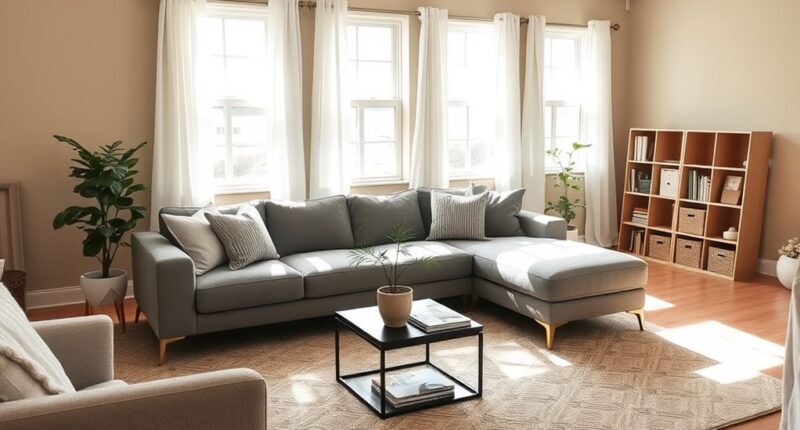When you move into a new home, start by prioritizing your immediate needs like unpacking essentials and addressing urgent repairs. Then, plan your budget carefully, measuring spaces to create a functional layout. Focus on versatile furniture, smart storage, and a cohesive color scheme. Add personal touches and lighting to make the space welcoming. Establish maintenance routines to keep everything organized. If you continue exploring, you’ll discover how to make your new space both practical and cozy.
Key Takeaways
- Prioritize unpacking essentials and addressing urgent repairs to ensure safety and comfort immediately after moving in.
- Measure spaces accurately and create scaled floor plans to optimize furniture placement and traffic flow.
- Implement versatile storage solutions like built-in shelves and labeled containers to maintain organization.
- Choose a cohesive color palette and style theme to create a harmonious, personalized interior aesthetic.
- Establish routines for regular home maintenance and cleaning to keep the environment functional and cozy.
Assess Your Immediate Needs and Prioritize Tasks
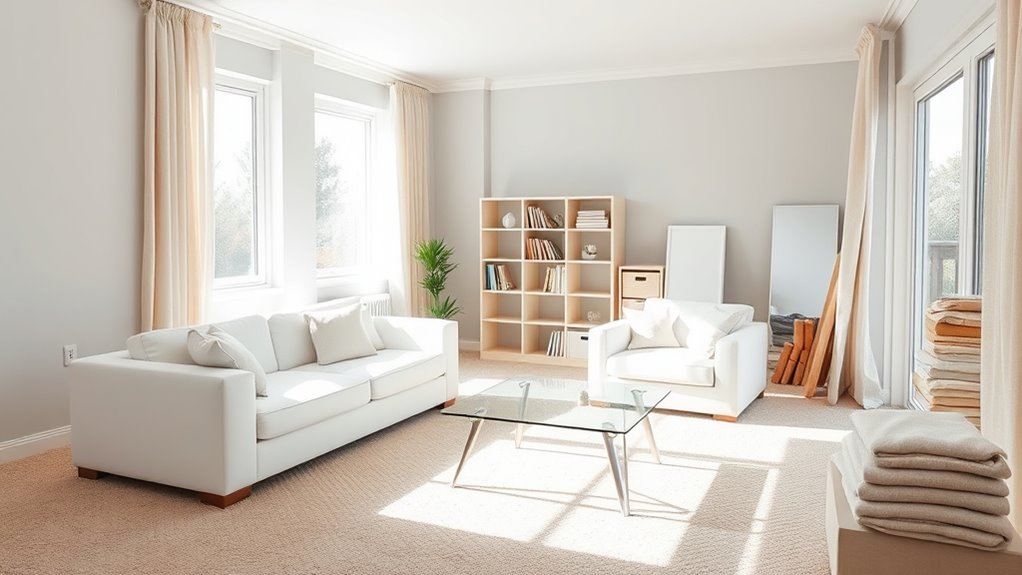
Before diving into unpacking and decorating, it’s vital to identify your immediate needs and prioritize tasks. Start by unpacking essentials—clothes, toiletries, basic kitchen items—so you can settle in comfortably. Focus on areas that need immediate repairs or fixes, like leaky faucets or loose door handles, to guarantee safety and functionality. Address these urgent issues first to prevent further damage or inconvenience. As you unpack, keep a checklist of what’s missing or damaged, and plan to handle repairs promptly. Avoid getting sidetracked by non-essential items or decorative touches until your basic needs are met. Prioritizing these tasks helps you create a safe, functional space that’s ready for the more detailed decorating phases later on. Incorporate self watering plant pots to ensure your greenery stays healthy without constant attention, especially during busy times.
Plan and Allocate Your Budget Effectively

Creating a realistic budget is essential to guarantee your interior design plans stay on track without overspending. Start by listing all costs, including moving expenses and renovation costs. Moving expenses can add up quickly, so allocate funds for professional movers, packing supplies, and transportation. Renovation costs vary depending on the scope of work; set aside a contingency fund for unexpected issues. Prioritize your needs and wants, and assign a specific budget to each category. Be honest about what you can afford, and avoid stretching your finances thin. Regularly review your budget as plans develop, ensuring you stay within your limits. Understanding cost estimation techniques can help you plan more accurately. This approach keeps your project manageable and prevents financial stress, making your move-in process smoother and more enjoyable.
Measure Spaces and Create a Functional Layout
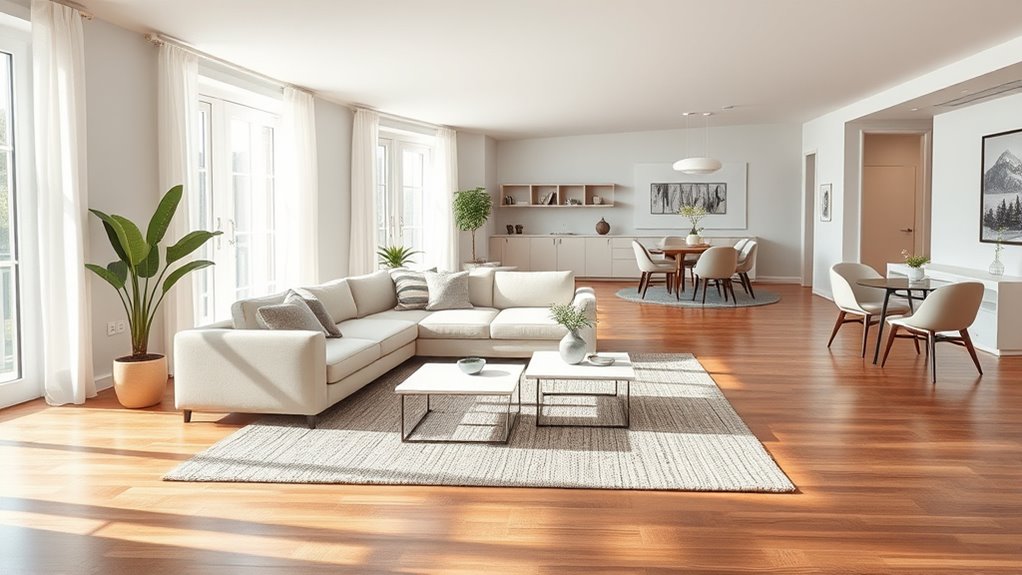
Start by measuring each room accurately, including walls, doorways, windows, and any built-in features. This guarantees precise space planning and helps you determine furniture placement options. With these measurements, you can create a scaled floor plan to visualize how furniture fits and flows. Keep in mind:
Measure each space carefully for accurate planning and optimal furniture placement.
- Consider traffic flow and ease of movement
- Prioritize functional zones for different activities
- Leave enough space for door swings and walkways
- Think about natural light sources when placing furniture
- Use versatile pieces to maximize small spaces
- Remember to account for necessary cookies that support basic site functionalities during your planning process to ensure smooth online browsing while researching your interior design ideas.
Choose a Cohesive Color Palette and Style Theme
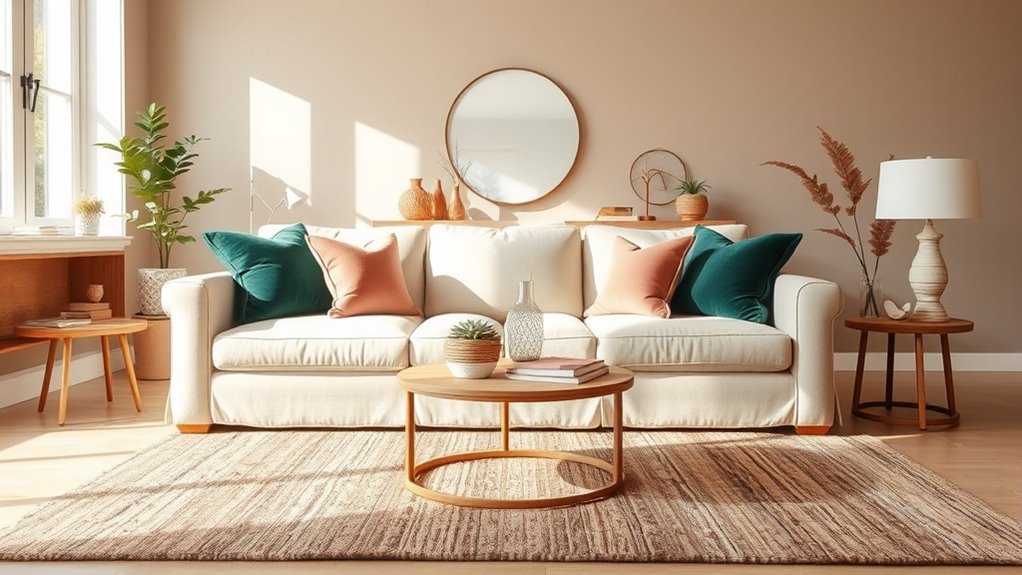
Once you’ve measured your spaces and sketched out a functional layout, it’s time to contemplate how color and style will tie everything together. Choosing a cohesive color palette helps establish color harmony throughout your home, creating a unified look. Start by selecting base colors for walls and larger furniture, then add accent shades for accessories and smaller items. When considering style theme, focus on style coordination—whether you prefer modern, rustic, or eclectic—so all elements complement each other seamlessly. Keep in mind that sticking to a consistent style and color scheme prevents visual clutter and fosters a harmonious environment. Additionally, incorporating water park-inspired elements such as playful patterns or vibrant hues can add a refreshing touch to your decor. This foundation will make decorating easier, ensuring your new home feels thoughtfully curated and inviting.
Focus on Essential Furniture and Storage Solutions
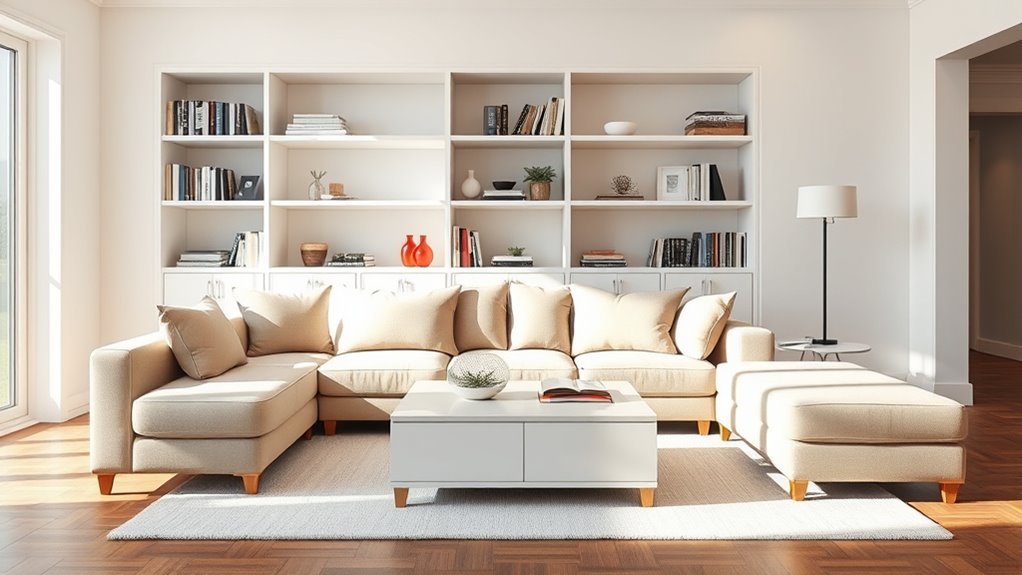
When setting up your new space, focus on the essential furniture pieces you need daily, like a comfortable sofa or a dining table. Incorporate smart storage solutions to keep your home organized and clutter-free, such as multifunctional furniture or built-in shelves. Prioritizing these elements guarantees your home is both functional and inviting from the start. Additionally, selecting innovative planters can enhance your interior decor while supporting healthy plant growth and adding a touch of nature to your living space.
Essential Furniture Must-Haves
Furnishing your new space with essential pieces guarantees both comfort and functionality from day one. Focus on versatile furniture that suits your lifestyle and reflects current decorating trends. These pieces serve as the foundation for your interior design and can be personalized with DIY projects for a unique touch. Prioritize items like a cozy sofa, a sturdy dining table, a comfortable bed, practical storage units, and a functional workspace. Remember, quality matters—invest in durable pieces that can adapt as your needs evolve. Incorporate stylish storage solutions to keep your space organized and clutter-free. When selecting furniture, consider multi-functional pieces, such as storage ottomans or fold-away desks, to maximize space and flexibility. Additionally, understanding contrast ratio helps in choosing lighting and display elements that enhance your interior ambiance and visual clarity. This approach ensures your home remains both stylish and practical.
Smart Storage Solutions
Smart storage solutions are essential for maintaining an organized and clutter-free home, especially in smaller spaces. Multi-functional furniture, like beds with built-in drawers or ottomans with hidden compartments, maximizes every inch of your home. Modular storage systems offer flexibility, allowing you to customize your storage as your needs change. Use stackable boxes, wall-mounted shelves, or adjustable closets to keep belongings accessible and tidy. Incorporate furniture that serves dual purposes, such as a sofa bed or a dining table with storage underneath. These smart solutions help you optimize space without sacrificing style. By choosing adaptable, multi-purpose pieces, you create a more functional environment that simplifies daily living and keeps your new home feeling spacious. Planning your storage strategy carefully can further enhance your home’s organization and efficiency.
Decorate With Personal Touches and Lighting
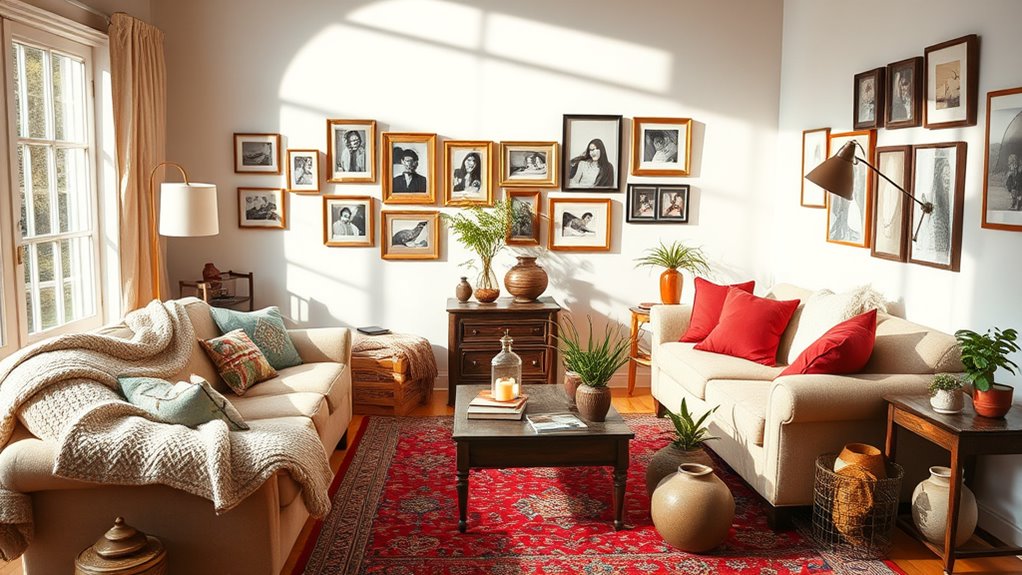
Adding personal touches and thoughtful lighting can transform your new space from plain to inviting. Incorporate meaningful decor that reflects your personality, like artwork, photos, or heirlooms, to make your home uniquely yours. Use lighting accents such as table lamps, string lights, or sconces to create warmth and ambiance. These elements not only brighten your space but also add depth and character. To enhance your decor, consider:
- Displaying favorite photos or artwork on walls
- Incorporating cozy throw blankets and pillows
- Using candles or LED candles for soft lighting
- Adding decorative vases or sculptures
- Integrating string or fairy lights for a charming glow
- Understanding symbolism in decor and lighting can help you select pieces that resonate deeply with your personal style and intentions.
These personal touches and lighting accents make your new house feel like a true home.
Set Up Systems for Maintenance and Organization

Establishing efficient systems for maintenance and organization early on can save you time and prevent clutter from piling up. Start by creating a cleaning routine that fits your schedule—daily, weekly, and monthly tasks—so chores don’t become overwhelming. Set up designated spots for home repair supplies, tools, and emergency kits, making them easy to access when needed. Use storage solutions like labeled bins or shelves to keep clutter in check and streamline your cleaning routines. Regularly review and update these systems to adapt to your changing needs. Incorporating storage solutions that maximize space can further enhance your home organization. Implementing these habits now guarantees your home remains functional, tidy, and well-maintained, reducing stress and making future upkeep much more manageable.
Frequently Asked Questions
How Do I Decide Which Rooms to Prioritize First?
You should prioritize rooms based on your daily needs and how you use your space. Start with the living room or kitchen, focusing on room layout and furniture placement, so you can relax and cook comfortably. Next, tackle bedrooms for rest and privacy. Address high-traffic areas first, ensuring they’re functional. By organizing your priorities around essential spaces, you’ll create a smooth flow and a more comfortable home quickly.
What Are Cost-Effective Ways to Update My New Home’s Look?
To give your home a fresh look without breaking the bank, focus on budget-friendly updates like new throw pillows, artwork, or rugs. DIY decor ideas, such as repainting furniture or creating your own wall art, can make a big impact. Prioritize high-traffic areas first to maximize style and comfort. You’ll save money and add personality by mixing simple upgrades with creative, cost-effective touches that reflect your style.
How Can I Make Small Spaces Feel Larger?
Imagine your small space as a tiny boat on a vast sea, longing to feel bigger. You can achieve this by choosing space-saving furniture that maximizes every inch and using color expansion techniques—light, neutral shades that reflect light and create an airy feel. Mirrors also act like windows, opening up the room visually. With these strategies, your space feels larger, brighter, and more inviting, transforming your tiny boat into a spacious vessel.
Which Lighting Options Are Best for Different Rooms?
When choosing lighting for different rooms, you want to focus on ambient and task lighting. In living rooms, use ambient lighting like ceiling fixtures or wall sconces to create a warm glow, while task lighting such as floor lamps or table lamps helps with reading or activities. For kitchens and bathrooms, install bright task lighting around work areas, and add ambient lighting to set a cozy mood. This combination guarantees functionality and comfort in every space.
How Often Should I Review and Adjust My Organization Systems?
You should review and adjust your organization systems regularly to keep your space functional. Every few months, assess your storage solutions to see if they still meet your needs, and update cleaning schedules to maintain cleanliness. As your routines or household size change, tweak your systems accordingly. Staying proactive guarantees your home remains organized, efficient, and easy to manage, making daily life smoother and more enjoyable.
Conclusion
settling into your new home takes time and effort, but don’t rush the process. Focus on what truly matters first, and gradually add personal touches to make it yours. Remember, Rome wasn’t built in a day, so be patient and enjoy the journey. With a clear plan and a little creativity, your space will feel like home before you know it. Keep your eye on the prize and stay organized—you’re well on your way!
